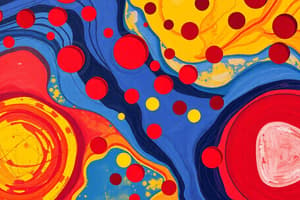Podcast
Questions and Answers
Which of the following is a direct oral anticoagulant (DOAC) that directly inhibits factor Xa?
Which of the following is a direct oral anticoagulant (DOAC) that directly inhibits factor Xa?
Lymph from the right arm and the right side of the head and thorax drains into the:
Lymph from the right arm and the right side of the head and thorax drains into the:
Which of the following is a fibrinolytic drug that converts plasminogen to plasmin?
Which of the following is a fibrinolytic drug that converts plasminogen to plasmin?
A patient presents with a deep vein thrombosis. Which of the following would be most appropriate to break down the existing clot?
A patient presents with a deep vein thrombosis. Which of the following would be most appropriate to break down the existing clot?
Which part of the eosinophil is responsible for the release of major basic protein, a key component in the immune response against parasites?
Which part of the eosinophil is responsible for the release of major basic protein, a key component in the immune response against parasites?
Which clotting factor acts as a carrier protein for factor VIII and mediates platelet adhesion?
Which clotting factor acts as a carrier protein for factor VIII and mediates platelet adhesion?
Which anticoagulant acts by binding to antithrombin III and accelerating its activity?
Which anticoagulant acts by binding to antithrombin III and accelerating its activity?
A patient presents with an increased number of immature myeloid cells in the bone marrow and peripheral blood. Which of the following is the most likely diagnosis?
A patient presents with an increased number of immature myeloid cells in the bone marrow and peripheral blood. Which of the following is the most likely diagnosis?
Which type of leukemia is characterized by the presence of smudge cells on a peripheral blood smear?
Which type of leukemia is characterized by the presence of smudge cells on a peripheral blood smear?
Which tonsil is located at the back of the nasopharynx?
Which tonsil is located at the back of the nasopharynx?
A patient presents with a Philadelphia chromosome (t(9;22)). Which of the following hematologic malignancies is most likely associated with this finding?
A patient presents with a Philadelphia chromosome (t(9;22)). Which of the following hematologic malignancies is most likely associated with this finding?
A child presents with a rapidly growing tumor in the jaw. Microscopic examination reveals a 'starry sky' pattern. Which of the following is the most likely diagnosis?
A child presents with a rapidly growing tumor in the jaw. Microscopic examination reveals a 'starry sky' pattern. Which of the following is the most likely diagnosis?
Which immunosuppressant drug inhibits the production of interleukin-2, thus preventing T-cell activation and proliferation?
Which immunosuppressant drug inhibits the production of interleukin-2, thus preventing T-cell activation and proliferation?
Which type of lymphocyte is crucial for initiating the immune response against intracellular pathogens and activating other immune cells?
Which type of lymphocyte is crucial for initiating the immune response against intracellular pathogens and activating other immune cells?
Which virus is associated with infectious mononucleosis and is implicated in the development of certain lymphomas?
Which virus is associated with infectious mononucleosis and is implicated in the development of certain lymphomas?
Which enzyme is crucial for the conversion of fibrinogen to fibrin in the coagulation cascade?
Which enzyme is crucial for the conversion of fibrinogen to fibrin in the coagulation cascade?
Which plasma protein is responsible for transporting copper in the blood and plays a role in iron metabolism?
Which plasma protein is responsible for transporting copper in the blood and plays a role in iron metabolism?
A patient with a history of cirrhosis presents with elevated alpha-fetoprotein levels. Which of the following is the most likely diagnosis?
A patient with a history of cirrhosis presents with elevated alpha-fetoprotein levels. Which of the following is the most likely diagnosis?
In the lymph node, where do macrophages and plasma cells reside, playing a critical role in antigen presentation and antibody production?
In the lymph node, where do macrophages and plasma cells reside, playing a critical role in antigen presentation and antibody production?
Which type of cell is responsible for the production and secretion of antibodies?
Which type of cell is responsible for the production and secretion of antibodies?
A patient presents with painless lymphadenopathy, fever, night sweats, and weight loss. A biopsy reveals Reed-Sternberg cells. What is the most likely diagnosis?
A patient presents with painless lymphadenopathy, fever, night sweats, and weight loss. A biopsy reveals Reed-Sternberg cells. What is the most likely diagnosis?
Which bacterium is a common cause of skin infections, such as impetigo and folliculitis?
Which bacterium is a common cause of skin infections, such as impetigo and folliculitis?
Which protozoan parasite is transmitted by the sandfly and causes visceral leishmaniasis, also known as kala-azar?
Which protozoan parasite is transmitted by the sandfly and causes visceral leishmaniasis, also known as kala-azar?
Which bacterial enzyme converts fibrinogen to fibrin, contributing to the formation of a protective barrier around the bacteria?
Which bacterial enzyme converts fibrinogen to fibrin, contributing to the formation of a protective barrier around the bacteria?
Which class of drugs is used in the treatment of acute lymphoblastic leukemia to interfere with DNA synthesis?
Which class of drugs is used in the treatment of acute lymphoblastic leukemia to interfere with DNA synthesis?
A patient receiving thrombolytic therapy for a myocardial infarction develops hematuria and epistaxis. Which of the following is the most likely cause?
A patient receiving thrombolytic therapy for a myocardial infarction develops hematuria and epistaxis. Which of the following is the most likely cause?
What is the normal range for white blood cell count in adults?
What is the normal range for white blood cell count in adults?
In the spleen, which area is rich in T lymphocytes and plays a crucial role in the immune response to blood-borne antigens?
In the spleen, which area is rich in T lymphocytes and plays a crucial role in the immune response to blood-borne antigens?
What is the primary function of B lymphocytes in the immune system?
What is the primary function of B lymphocytes in the immune system?
Which type of granulocyte is involved in allergic reactions and releases histamine and heparin?
Which type of granulocyte is involved in allergic reactions and releases histamine and heparin?
Which parasitic nematode is transmitted by mosquitoes and causes lymphatic filariasis, leading to elephantiasis?
Which parasitic nematode is transmitted by mosquitoes and causes lymphatic filariasis, leading to elephantiasis?
A patient experiences intense pain and vasoconstriction following a deep laceration. Which of the following is the most likely mechanism responsible for these immediate responses?
A patient experiences intense pain and vasoconstriction following a deep laceration. Which of the following is the most likely mechanism responsible for these immediate responses?
Which of the following is a common cause of lymphocytosis, characterized by an increase in the number of lymphocytes in the blood?
Which of the following is a common cause of lymphocytosis, characterized by an increase in the number of lymphocytes in the blood?
Which cell is the 1st precursor to all lymphoid cells, including T cells, B cells, and NK cells?
Which cell is the 1st precursor to all lymphoid cells, including T cells, B cells, and NK cells?
A young adult presents with mediastinal lymphadenopathy. A biopsy shows lacunar cells and fibrous bands dividing the lymph node into nodules. Which subtype of Hodgkin lymphoma is most likely?
A young adult presents with mediastinal lymphadenopathy. A biopsy shows lacunar cells and fibrous bands dividing the lymph node into nodules. Which subtype of Hodgkin lymphoma is most likely?
Which type of white blood cell is the most abundant in the peripheral blood and plays a crucial role in phagocytosis and the destruction of bacteria?
Which type of white blood cell is the most abundant in the peripheral blood and plays a crucial role in phagocytosis and the destruction of bacteria?
Which cell is the hallmark of Hodgkin lymphoma and is characterized by its large size and bilobed or multilobulated nucleus with prominent nucleoli?
Which cell is the hallmark of Hodgkin lymphoma and is characterized by its large size and bilobed or multilobulated nucleus with prominent nucleoli?
A patient undergoes hip replacement surgery. Low molecular weight heparin is prescribed postoperatively. What is the primary reason for this treatment?
A patient undergoes hip replacement surgery. Low molecular weight heparin is prescribed postoperatively. What is the primary reason for this treatment?
How is the parasite that causes lymphatic filariasis, leading to elephantiasis, typically transmitted to humans?
How is the parasite that causes lymphatic filariasis, leading to elephantiasis, typically transmitted to humans?
Which type of leukemia is characterized by the presence of 'hairy' cells with cytoplasmic projections and is often associated with splenomegaly?
Which type of leukemia is characterized by the presence of 'hairy' cells with cytoplasmic projections and is often associated with splenomegaly?




